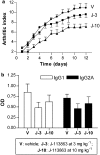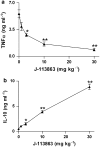Pharmacological blockade of CCR1 ameliorates murine arthritis and alters cytokine networks in vivo
- PMID: 17016504
- PMCID: PMC2014657
- DOI: 10.1038/sj.bjp.0706912
Pharmacological blockade of CCR1 ameliorates murine arthritis and alters cytokine networks in vivo
Abstract
Background and purpose: The chemokine receptor CCR1 is a potential target for the treatment of rheumatoid arthritis. To explore the impact of CCR1 blockade in experimental arthritis and the underlying mechanisms, we used J-113863, a non-peptide antagonist of the mouse receptor.
Experimental approach: Compound J-113863 was tested in collagen-induced arthritis (CIA) and three models of acute inflammation; Staphylococcus enterotoxin B (SEB)-induced interleukin-2 (IL-2), delayed-type hypersensitivity (DTH) response, and lipopolysaccharide (LPS)-induced tumour necrosis factoralpha (TNFalpha) production. In the LPS model, CCR1 knockout, adrenalectomised, or IL-10-depleted mice were also used. Production of TNFalpha by mouse macrophages and human synovial membrane samples in vitro were also studied.
Key results: Treatment of arthritic mice with J-113863 improved paw inflammation and joint damage, and dramatically decreased cell infiltration into joints. The compound did not inhibit IL-2 or DTH, but reduced plasma TNFalpha levels in LPS-treated mice. Surprisingly, CCR1 knockout mice produced more TNFalpha than controls in response to LPS, and J-113863 decreased TNFalpha also in CCR1 null mice, indicating that its effect was unrelated to CCR1. Adrenalectomy or neutralisation of IL-10 did not prevent inhibition of TNFalpha production by J-113863. The compound did not inhibit mouse TNFalpha in vitro, but did induce a trend towards increased TNFalpha release in cells from synovial membranes of rheumatoid arthritis patients.
Conclusions and implications: CCR1 blockade improves the development of CIA, probably via inhibition of inflammatory cell recruitment. However, results from both CCR1-deficient mice and human synovial membranes suggest that, in some experimental settings, blocking CCR1 could enhance TNF production.
Figures








Similar articles
-
Protection against cartilage and bone destruction by systemic interleukin-4 treatment in established murine type II collagen-induced arthritis.Arthritis Res. 1999;1(1):81-91. doi: 10.1186/ar14. Epub 1999 Oct 26. Arthritis Res. 1999. PMID: 11056663 Free PMC article.
-
The human specific CCR1 antagonist CP-481,715 inhibits cell infiltration and inflammatory responses in human CCR1 transgenic mice.J Immunol. 2006 Mar 1;176(5):3141-8. doi: 10.4049/jimmunol.176.5.3141. J Immunol. 2006. PMID: 16493073
-
MIP-1alpha[CCL3] acting on the CCR1 receptor mediates neutrophil migration in immune inflammation via sequential release of TNF-alpha and LTB4.J Leukoc Biol. 2005 Jul;78(1):167-77. doi: 10.1189/jlb.0404237. Epub 2005 Apr 14. J Leukoc Biol. 2005. PMID: 15831559
-
A potent and selective p38 inhibitor protects against bone damage in murine collagen-induced arthritis: a comparison with neutralization of mouse TNFalpha.Br J Pharmacol. 2008 May;154(1):153-64. doi: 10.1038/bjp.2008.53. Epub 2008 Feb 25. Br J Pharmacol. 2008. PMID: 18297096 Free PMC article.
-
Apremilast, a novel PDE4 inhibitor, inhibits spontaneous production of tumour necrosis factor-alpha from human rheumatoid synovial cells and ameliorates experimental arthritis.Arthritis Res Ther. 2010;12(3):R107. doi: 10.1186/ar3041. Epub 2010 Jun 2. Arthritis Res Ther. 2010. PMID: 20525198 Free PMC article.
Cited by
-
Chemokines in rheumatic diseases: pathogenic role and therapeutic implications.Nat Rev Rheumatol. 2019 Dec;15(12):731-746. doi: 10.1038/s41584-019-0323-6. Epub 2019 Nov 8. Nat Rev Rheumatol. 2019. PMID: 31705045 Review.
-
CCR5 is involved in resolution of inflammation in proteoglycan-induced arthritis.Arthritis Rheum. 2009 Oct;60(10):2945-53. doi: 10.1002/art.24842. Arthritis Rheum. 2009. PMID: 19790057 Free PMC article.
-
Chemokine-mediated inflammation in the degenerating retina is coordinated by Müller cells, activated microglia, and retinal pigment epithelium.J Neuroinflammation. 2015 Jan 17;12:8. doi: 10.1186/s12974-014-0224-1. J Neuroinflammation. 2015. PMID: 25595590 Free PMC article.
-
Macrophages and angiogenesis in rheumatic diseases.Vasc Cell. 2013 Jun 1;5(1):11. doi: 10.1186/2045-824X-5-11. Vasc Cell. 2013. PMID: 23725043 Free PMC article.
-
Chemokine (C-C Motif) receptor 1 is required for efficient recruitment of neutrophils during respiratory infection with modified vaccinia virus Ankara.J Virol. 2014 Sep;88(18):10840-50. doi: 10.1128/JVI.01524-14. Epub 2014 Jul 9. J Virol. 2014. PMID: 25008920 Free PMC article.
References
-
- Anders H, Belemezova E, Eis S, Segerer S, Vielhauer V, Perez de Lerma G, et al. Late onset of treatment with a chemokine receptor CCR1 antagonist prevents progression of lupus nephritis in MRL-Fas(lpr) mice. J Am Soc Nephro. 2004;15:1504–1513. - PubMed
-
- Blease K, Mehrad B, Standiford T, Lukacs N, Kunkel S, Chensue S, et al. Airway remodeling is absent in CCR1−/− mice during chronic fungal allergic airway disease. J Immunol. 2000;165:1564–1572. - PubMed
-
- Branger J, Van Den Blink B, Weijer S, Madwed J, Bos C, Gupta A, et al. Anti-inflammatory effects of a p38 mitogen-activated protein kinase inhibitor during human endotoxemia. J Immunol. 2002;168:4070–4077. - PubMed
Publication types
MeSH terms
Substances
Grants and funding
LinkOut - more resources
Full Text Sources
Other Literature Sources
Medical

